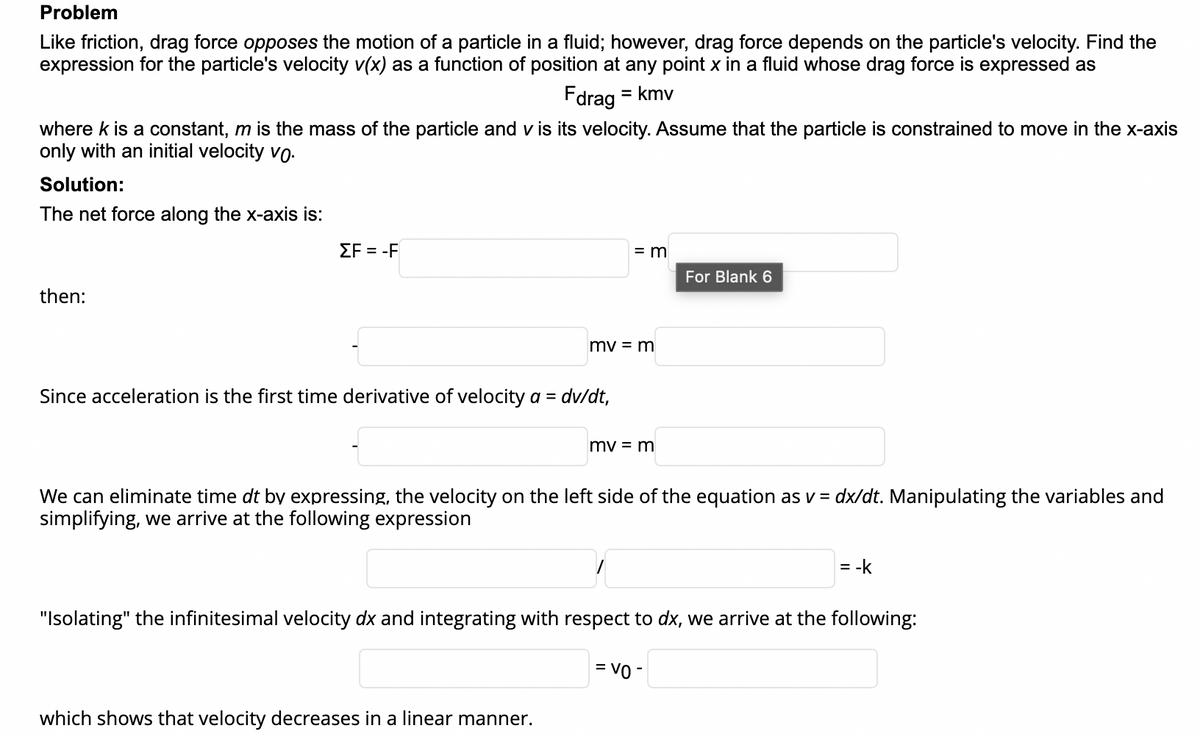Like friction, drag force opposes the motion of a particle in a fluid; however, drag force depends on the particle's velocity. Find the expression for the particle's velocity v(x) as a function of position at any point x in a fluid whose drag force is expressed as Fdrag = kmv where k is a constant, m is the mass of the particle and v is its velocity. Assume that the particle is constrained to move in the x-axis only with an initial velocity vo. Solution: The net force along the x-axis is: ΣF-F = m For Blank 6 then: mv = m Since acceleration is the first time derivative of velocity a = dv/dt, mv = m We can eliminate time dt by expressing, the velocity on the left side of the equation as v = dx/dt. Manipulating the variables and simplifying, we arrive at the following expression = -k "Isolating" the infinitesimal velocity dx and integrating with respect to dx, we arrive at the following: = Vo- which shows that velocity decreases in a linear manner.
Like friction, drag force opposes the motion of a particle in a fluid; however, drag force depends on the particle's velocity. Find the expression for the particle's velocity v(x) as a function of position at any point x in a fluid whose drag force is expressed as Fdrag = kmv where k is a constant, m is the mass of the particle and v is its velocity. Assume that the particle is constrained to move in the x-axis only with an initial velocity vo. Solution: The net force along the x-axis is: ΣF-F = m For Blank 6 then: mv = m Since acceleration is the first time derivative of velocity a = dv/dt, mv = m We can eliminate time dt by expressing, the velocity on the left side of the equation as v = dx/dt. Manipulating the variables and simplifying, we arrive at the following expression = -k "Isolating" the infinitesimal velocity dx and integrating with respect to dx, we arrive at the following: = Vo- which shows that velocity decreases in a linear manner.
College Physics
11th Edition
ISBN:9781305952300
Author:Raymond A. Serway, Chris Vuille
Publisher:Raymond A. Serway, Chris Vuille
Chapter1: Units, Trigonometry. And Vectors
Section: Chapter Questions
Problem 1CQ: Estimate the order of magnitude of the length, in meters, of each of the following; (a) a mouse, (b)...
Related questions
Question
Hi can you help me find the solution to this?

Transcribed Image Text:Problem
Like friction, drag force opposes the motion of a particle in a fluid; however, drag force depends on the particle's velocity. Find the
expression for the particle's velocity v(x) as a function of position at any point x in a fluid whose drag force is expressed as
Fdrag=
= kmy
where k is a constant, m is the mass of the particle and v is its velocity. Assume that the particle is constrained to move in the x-axis
only with an initial velocity vO-
Solution:
The net force along the x-axis is:
ΣF - -F
= m
For Blank 6
then:
mv = m
Since acceleration is the first time derivative of velocity a = dv/dt,
%3D
mv = m
We can eliminate time dt by expressing, the velocity on the left side of the equation as v = dx/dt. Manipulating the variables and
simplifying, we arrive at the following expression
= -k
"Isolating" the infinitesimal velocity dx and integrating with respect to dx, we arrive at the following:
= Vo -
which shows that velocity decreases in a linear manner.

Transcribed Image Text:Calculated Answers
Express your answers without rounding off and without scientific notation unless instructed otherwise. Do not include the units.
Multiple Blanks
Write powers or subscript as is. Ex: Use b2 if you mean
b2
or b2
Write transcendental functions as is. Ex. Use costheta if you mean cose.
Spell out Greek letters. Ex: Use pi if you mean A
Write answers without spaces. Ex: Use 2epsilonOr3 if you mean 2e r3.
Write fractions with a slash. Ex: Use 1/2 if you mean
Expert Solution
This question has been solved!
Explore an expertly crafted, step-by-step solution for a thorough understanding of key concepts.
This is a popular solution!
Trending now
This is a popular solution!
Step by step
Solved in 2 steps

Knowledge Booster
Learn more about
Need a deep-dive on the concept behind this application? Look no further. Learn more about this topic, physics and related others by exploring similar questions and additional content below.Recommended textbooks for you

College Physics
Physics
ISBN:
9781305952300
Author:
Raymond A. Serway, Chris Vuille
Publisher:
Cengage Learning

University Physics (14th Edition)
Physics
ISBN:
9780133969290
Author:
Hugh D. Young, Roger A. Freedman
Publisher:
PEARSON

Introduction To Quantum Mechanics
Physics
ISBN:
9781107189638
Author:
Griffiths, David J., Schroeter, Darrell F.
Publisher:
Cambridge University Press

College Physics
Physics
ISBN:
9781305952300
Author:
Raymond A. Serway, Chris Vuille
Publisher:
Cengage Learning

University Physics (14th Edition)
Physics
ISBN:
9780133969290
Author:
Hugh D. Young, Roger A. Freedman
Publisher:
PEARSON

Introduction To Quantum Mechanics
Physics
ISBN:
9781107189638
Author:
Griffiths, David J., Schroeter, Darrell F.
Publisher:
Cambridge University Press

Physics for Scientists and Engineers
Physics
ISBN:
9781337553278
Author:
Raymond A. Serway, John W. Jewett
Publisher:
Cengage Learning

Lecture- Tutorials for Introductory Astronomy
Physics
ISBN:
9780321820464
Author:
Edward E. Prather, Tim P. Slater, Jeff P. Adams, Gina Brissenden
Publisher:
Addison-Wesley

College Physics: A Strategic Approach (4th Editio…
Physics
ISBN:
9780134609034
Author:
Randall D. Knight (Professor Emeritus), Brian Jones, Stuart Field
Publisher:
PEARSON